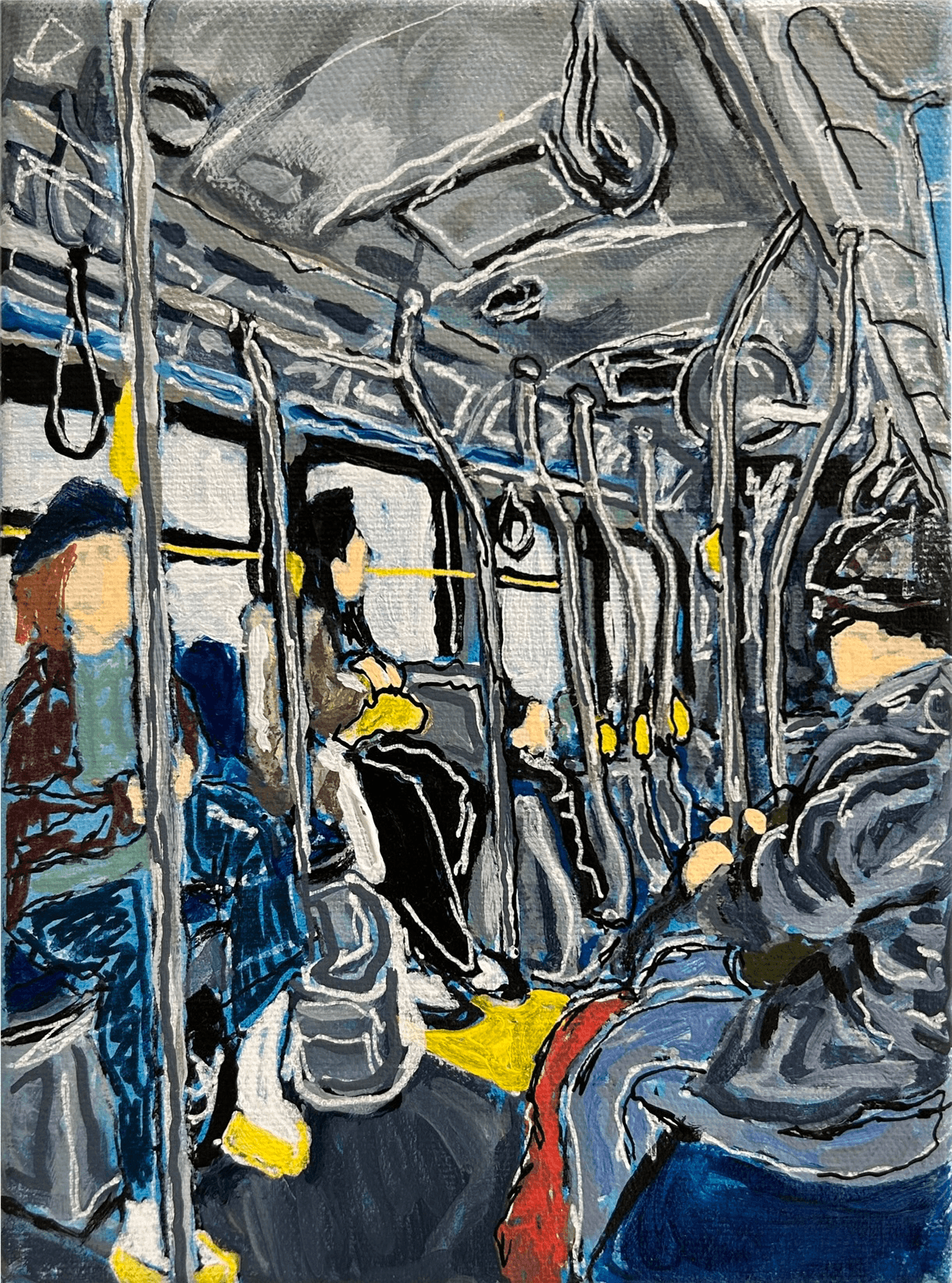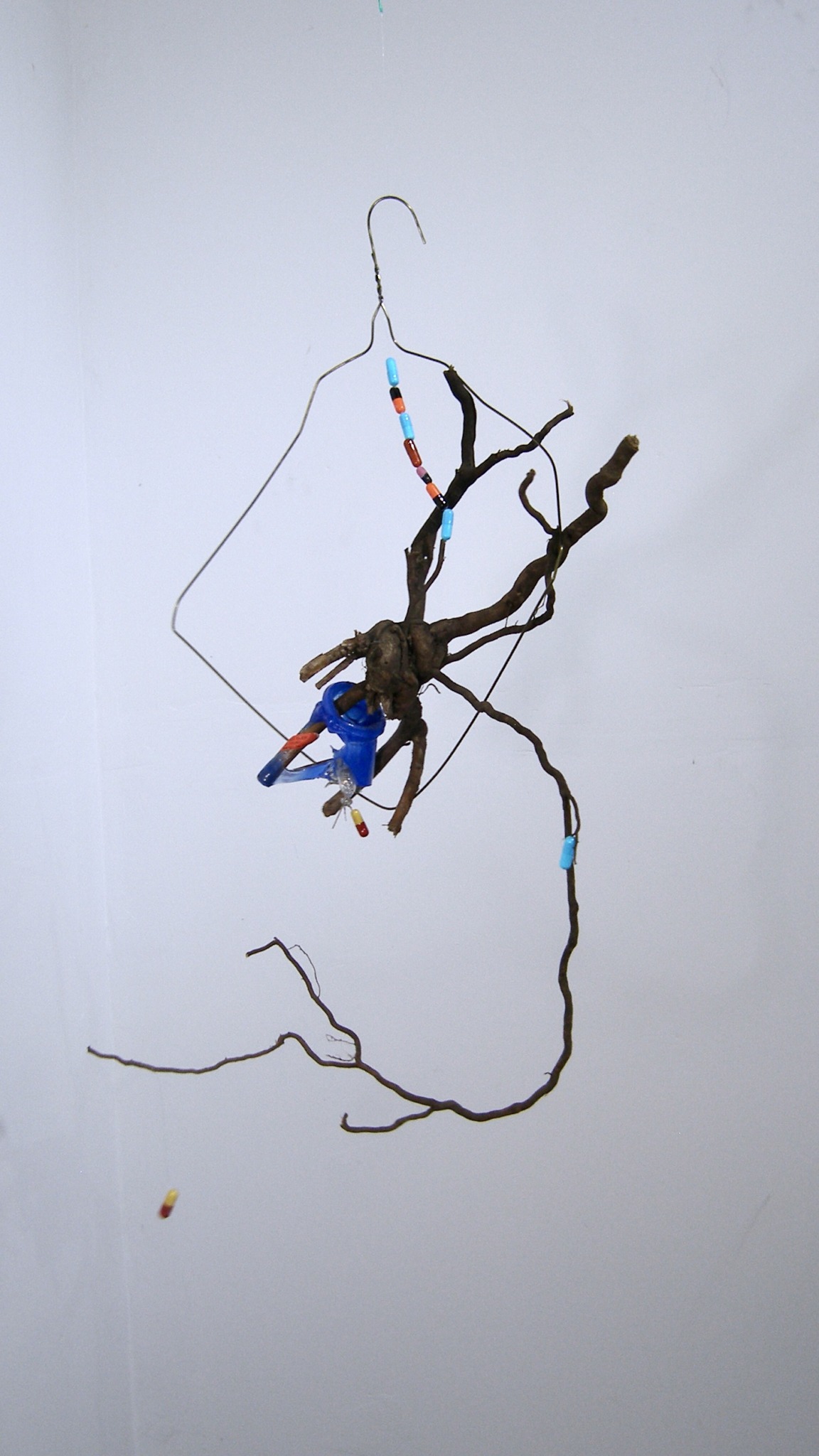We were lucky to catch up with Liz Saunders recently and have shared our conversation below.
Liz, thanks for taking the time to share your stories with us today We’d love to hear about a project that you’ve worked on that’s meant a lot to you.
The most meaningful project I’ve worked on would likely be my kinetic sculptural mobiles, as the concepts behind them gave life to my painting series ‘Commuter’s Paradise’. I started building these mobiles while still in art school – I had begun my studies with the intention of focussing solely on painting, but within the first year or two struggles with chronic pain had me switch into sculpture. I felt drawn from there to explore found object sculpture, the notion of turning everyday detritus that would normally go overlooked and unloved into something one couldn’t look away from. By suspending these objects mid-air, I delighted in witnessing a sense of movement overcome them, almost as though they were dancing and alive. Soon, I realized a sort of formula for selecting my materials which made the sculptures so much more meaningful to me. Having lived with chronic illness since age 4, and requiring the use of technology to manage it throughout my life via medical devices, it became important to me to integrate these material references to medication in my practice. I felt as though I were bringing light and appreciation to some of the intricate systems within our bodies that we take for granted. This too was influenced by how intensely we can use our bodies when young, almost taking for granted that it won’t always be so easy to do certain things. By expanding the concept of homeostasis to other systems within our lives that we take for granted but depend on, I found myself integrating material references to nature, architecture, and our digitized world – the unseen roots we walk over that so readily offer life to the trees we appreciate, the collection of wires behind drywall that discretely encompass our bodies in a room and allow us to see with the flick of a switch, and the intricate systems housed in devices like smartphones. By combining all these material references in kinetic sculpture, I felt a catharsis in watching the mobiles dance, almost as though all these systems worked together within the ‘body’ of the artwork to bring it to life.


As always, we appreciate you sharing your insights and we’ve got a few more questions for you, but before we get to all of that can you take a minute to introduce yourself and give our readers some of your back background and context?
I’m a Canadian painter and sculptor currently based in Victoria, B.C. By drawing on my experience of living with chronic illness since childhood, my work explores parallels between the human body and various systems that we depend on in modern life but tend to take for granted. With a background in self-taught portraiture, I entered art school with the intention of focussing only on painting. Soon, issues with chronic pain brought a halt to this endeavour, leading me to explore what else my university had to offer. I took courses in various media, from sound design and creative electronics to film and sculpture. Sculpture became the primary focus of my studies, with a particular fascination for found objects and electronics as I found these materials the most meaningful to my life and interests. I continued exhibiting and making my sculptural mobiles after graduating, then moved from my hometown of Vancouver to Victoria, B.C. Here, I felt a great deal less pressure than the constant opportunities and events offered by Vancouver – almost as though I’d stepped into a world where time passed more slowly. Having few contacts within the city and not knowing how to immerse myself in a new community, I returned to painting. This was aided by a friendlier climate for plein-air work, so I would spend hours biking with my art supplies, creating drawings and paintings while immersed in the environment of my subject. This loosened me up, and recalled the days of life drawing the human body at art school.. the rush of capturing whatever gesture you could have a subject within a short window of time. I began integrating this energy of working plein-air to my ‘Commuter’s Paradise’ painting series based off the sketches I would make in motion on the bus. After getting involved with a the local collective ‘Gage Gallery’, and obtaining studio space at Rockslide Gallery and studios, I found myself expanding these bus paintings, and am thrilled to know how treasured they are by my clients. Whether through sculpture or painting, seeing people spend time with my work brings me so much joy.

Are there any resources you wish you knew about earlier in your creative journey?
One thing I wish I’d realized early on is the importance of community to an artist. I went to art school when I was younger, and entered into it with attitudes that were, in hindsight, not conducive to the spirit of creativity and fostered so much more by living in a capitalistic and competitive culture. I thought that if I focussed on working hard and being the ‘best’, surely success would follow – being part of a community was simply an afterthought. I struggled a great deal with social anxiety, and it was easy to let that, combined with these beliefs I held, be a reason to avoid interacting with other artists. I took myself too seriously and didn’t realize what has now become a core belief within my practice – to centre it around play and experimentation. Of course, while I regret being so reclusive, I am still glad I went to art school and that my health issues prompted me to explore practices beyond my comfort zone of painting. I think without that, I wouldn’t have as much to say about my art now – I’m so grateful that my circumstances allowed me to delve into my practice in a meaningful way. While I my not have been exposed to as much community as I would have liked, or able to stick solely to such a lucrative path as focussing on painting alone, I was certainly exposed to a great deal of history, media and concepts that have continued to influence both my art and my life to this day.

Learning and unlearning are both critical parts of growth – can you share a story of a time when you had to unlearn a lesson?
Trusting the unknown… is a lesson I’m constantly learning, unlearning and relearning. It’s become so crucial to my practice to not try to control the outcome of a piece, and to trust that even when I have no idea what’s going to come of it, it’ll be what it’s meant to. I feel so often in the process of art making that it’s easy to become fixated in trying to force a piece to turn out as planned, but that the best work is often a happenstance of willpower and the unexpected. It’s almost as though I’m collaborating more with materials, than trying to force them to do my bidding. I suppose this concept is something that’s emerged in my practice over years of doing and undoing, and witnessing how much more I like work that I ‘let’ come into being by keeping my practice loose and experimental – that for me, the more I try to execute a plan for a piece should turn out, the less likely it’ll be something I actually enjoy making or viewing. Staying open to new opportunities, rolling with the unexpected, and embracing how plans can change has become a vitally important aspect of both my artistic practice and how I live my life.
Contact Info:
- Website: https://www.lizsaundersart.com
- Instagram: @lizsaunder — https://www.instagram.com/lizsaunder/?hl=en








